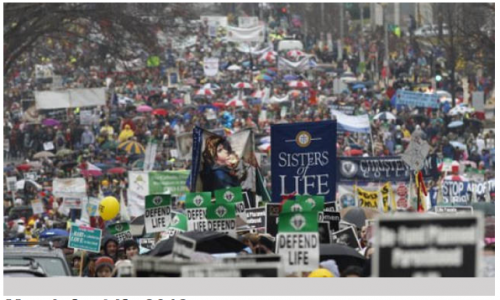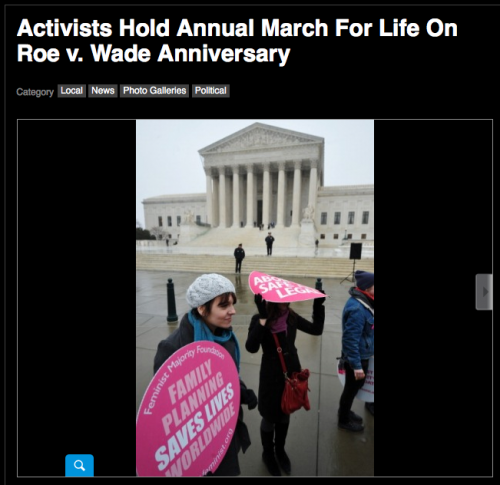 The online producers at CBS posted a photo slideshow the other day that appeared under the following rather literal headline:
The online producers at CBS posted a photo slideshow the other day that appeared under the following rather literal headline:
Activists Hold Annual March For Life On Roe v. Wade Anniversary
So, just thinking out loud, what percentage of the pictures in this gallery would you expect to be of, well, the thousands and thousands of activists who traveled to Washington, D.C., in order to take part in the annual March For Life on the anniversary of Roe v. Wade?
If you guessed anything other than zero, you would be wrong.
There are literally no pictures of any pro-lifers in this feature.
Instead, the entire slideshow consists of images such as the one embedded below. Really, go click through it, if you don't believe me. (UPDATE: Around 7:00 PM on January 26, photos of pro-lifers were added to the gallery.)
Now, it is true that each year at the March For Life, you can count on seeing a handful of pro-abortion-rights protesters. Usually around a half dozen to two dozen.
The March for Life, on the other hand, features many more. How many more? Well, I imagine that the estimate put out by organizers of half a million is an overstatement, but you get the idea. Perhaps you can take a gander at this picture of this year's (frigid, rain-soaked) march here that CBS was unable to get. One Mass -- alone -- at the National Shrine had an official attendance of 17,851. So basically about the same number on both sides, right?
No joke. Pro-lifers might recall the 2010 incident when CNN surmised that there might be more pro-choice activists at the annual March for Life than opponents of abortion. I'm not exaggerating. CNN's Rick Sanchez stated that "there are both sides being represented" and then asked his producer, "Which side is represented the most Angie, do we know?” He didn't get an answer and, thus, he went on to promise that CNN would “keep an eye” on the situation and report on the matter “fairly and squarely.”
When I noted in a recent post that the New York Times, which is normally accused of over-reporting on other protests, had failed to cover the march (again) and that the Washington Post was using weird language to describe Catholic doctrine on life issues, a commenter wrote:
It’s the third week of January so it must be time for the annual GR bashing of the MSM “coverage” of the annual “March for Life”.
 Yep! You got it. It must be about that time. It's really amazing, isn't it, that we don't fall all ourselves with praise for a media culture that ignores this large event.
Yep! You got it. It must be about that time. It's really amazing, isn't it, that we don't fall all ourselves with praise for a media culture that ignores this large event.
Now, thankfully you can get the news from other sources, thanks to the wonders of social media. But should you have to? Of course not.
So what gives? Why do the media fail at this so consistently, year after year after year? What is it? Pro-life writer Elizabeth Scalia has some thoughts:
Unfortunately, the “big picture” is hard to come by, particularly if you’re looking for “big pictures” of this well-attended march. We have reached a remarkable era of photojournalism, as demonstrated by the once-noble Washington Post — one where a half million people can march, the headlines can call it “thousands” and the pictures show you none of it.
Someone asked me on Twitter, “why don’t they just report the truth” and I thought, “because they have given themselves wholly over to a lie, and they fear the truth. Having built up the lie for so long that it’s become their foundation, they know they cannot withstand an assault by the truth.”
So they have become truth-phobics, our mainstream media. They can’t tell you the truth about anything, anymore — they can only do whatever it takes to sustain the narratives they’ve constructed. ...
You want the truth? You think you deserve it? The press can’t handle the truth; they can’t bring it to you. The New York Times just ignores inconvenient truth, entirely.
That’s why 250 people camping out in a park gets thousands of stories, while half-a-million marching on Washington does not get reported at all, or if it does, the pictures are cropped; the attendees are caricatured, mis-named and under-represented while their opponents are over-represented.
Scalia is writing from a particular point of view, obviously. But what do you think? Why do we see such problems year after year? What's going on? What can be done to help reporters do a better job? In the case of CBS, for instance, maybe a pro-life marcher could have simply tapped the photographer on the shoulder and told him to look behind himself at the large crowds marching by the Supreme Court for hours on Monday afternoon? Something like that? What else?
Image of actual activists in annual March For Life via Telecare. And h/t to Vestal Morons.
